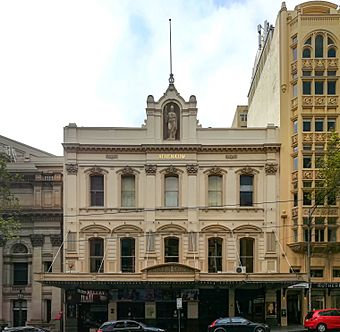Melbourne Athenaeum facts for kids

The Melbourne Athenaeum
|
|
| Address | 188 Collins Street Melbourne, Victoria Australia |
|---|---|
| Coordinates | 37°48′54″S 144°58′02″E / 37.81504°S 144.96736°E |
| Designation | Victorian Heritage Register, Register of Historic Buildings |
| Capacity | 880 (theatre one) |
| Current use | Live theatre, comedy, library, readings |
| Construction | |
| Opened | 1839 |
| Rebuilt | 1885-1886 |
| Years active | 186–187 |
| Architect | Smith & Johnson |
The Athenaeum or Melbourne Athenaeum is a famous place for art and culture in the heart of Melbourne, Victoria, Australia. You can find it at 188 Collins Street. It was started in 1839, making it Melbourne's oldest cultural building.
This building on Collins Street is across from the Regent Theatre. Today, it has a main theatre, a smaller studio theatre, a restaurant, and a subscription library. In the past, it was also a place for mechanics to learn, an art gallery, and a cinema.
Contents
Building Design
The Athenaeum building has a special look called neoclassical style. It was designed by architects Smith and Johnson. The building has three floors and was finished in 1886.
On top of the building, there is a statue of Minerva. Minerva is a Roman goddess of wisdom, arts, and literature. The building is very important and is listed on the Victorian Heritage Register. This means it is protected because of its history.
History of the Athenaeum
Early Days
In 1840, the Melbourne Mechanics Institution bought the land for the Athenaeum. The first building, called the Hall of Arts, was finished in 1842.
The first leader was Captain William Lonsdale. The first books were given by Henry Fyshe Gisborne. At first, it was called the Melbourne Mechanics' Institute. Later, in 1846, its name changed to the Melbourne Mechanics' Institution and School of Arts.
The Melbourne City Council used to meet on the ground floor until 1852. The government gave money to the Institute each year. By 1851, almost 500 people were members.
A new building started being built in 1855. The Institution changed its name to the Melbourne Athenaeum in 1872. The statue of Minerva on the building was paid for by a gift from Alderman Thomas Moubray.
The library was always a very important part of the Athenaeum. By 1877, there were over 1,600 members. In 1879, people visited the library 30,000 times.
Theatre and Movies
The first movie was shown at the Athenaeum Hall in October 1896. This was a very early movie showing in Australia. In 1901, a long film about life on a ship called HMS Jupiter was shown.
The Hall became a regular place to watch movies. The world's first dramatic feature film, The Story of the Kelly Gang, was shown here in 1906.
The theatre you see today, with 880 seats, was created in 1924. It was one of the first places in Australia to show "talking pictures." It showed The Jazz Singer in 1929. From the 1920s to the 1970s, it was mostly used as a cinema.
The Melbourne Theatre Company used the theatre from 1976 to 1985. The smaller studio theatre upstairs, called "Ath 2," is also used for plays and comedy shows.
Art Gallery
The Athenaeum also had an important art gallery. In 1910, famous artists like Walter Withers and Frederick McCubbin talked about using the Athenaeum for art shows. The upper hall was changed to become The Athenaeum Art Gallery. It had a special roof window to let in light for the artworks.
The first exhibition of Frederick McCubbin's famous painting The Pioneer was held here in 1904. Many well-known Australian artists showed their paintings at the gallery. Artists like Clarice Beckett, Rupert Bunny, Hans Heysen, Albert Namatjira, Tom Roberts, and Arthur Streeton all had exhibitions here. The gallery was very popular and artists had to book a year in advance. It closed in 1971.
Library for Members
The Athenaeum has a special library called a subscription library. This means you pay a fee to become a member and borrow books. In 1950, it had the most members ever, with over 7,500 people. This happened after the State Library of Victoria stopped lending books in 1939.
Over the years, the number of members went down. But now, more and more people are joining the library again.
The Athenaeum Today
Today, the Athenaeum Theatre is a busy place for live shows. You can see plays, comedy acts, and music performances. It is a main venue for the Melbourne International Comedy Festival. The Melbourne Opera also performs here.
The subscription library has about 30,000 books. It also holds regular events, talks, and book clubs for its members.
See also



